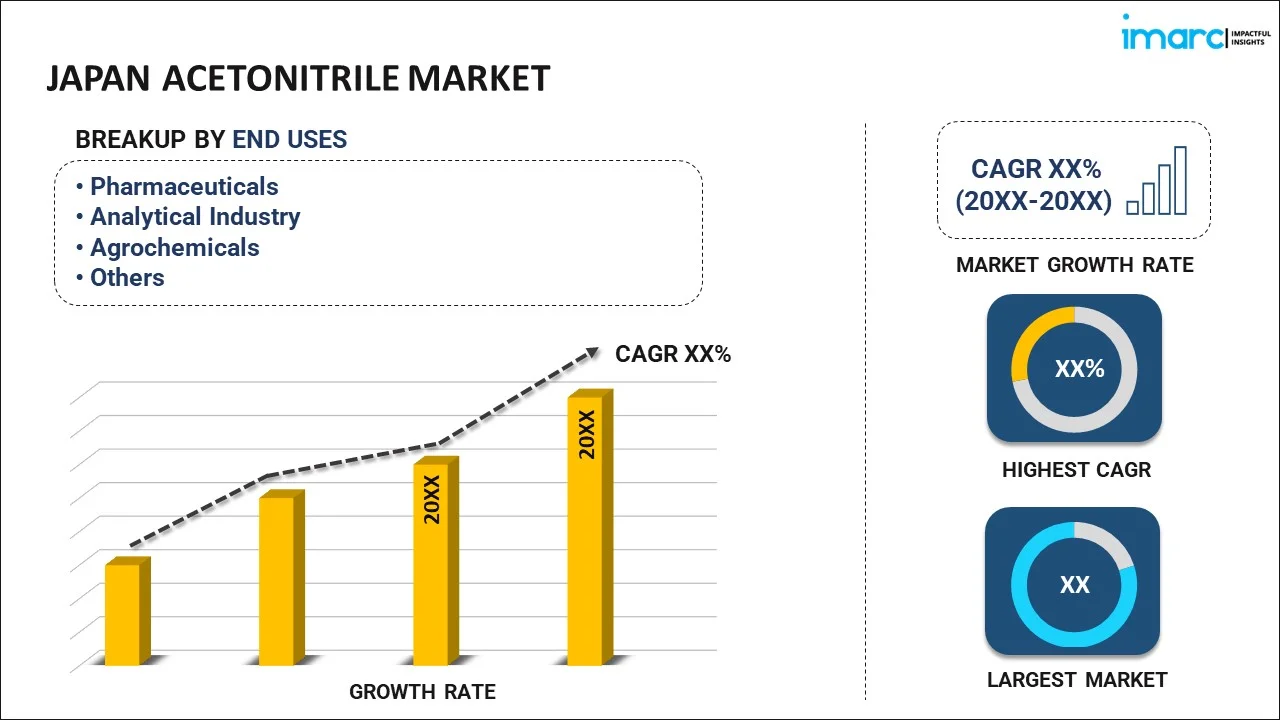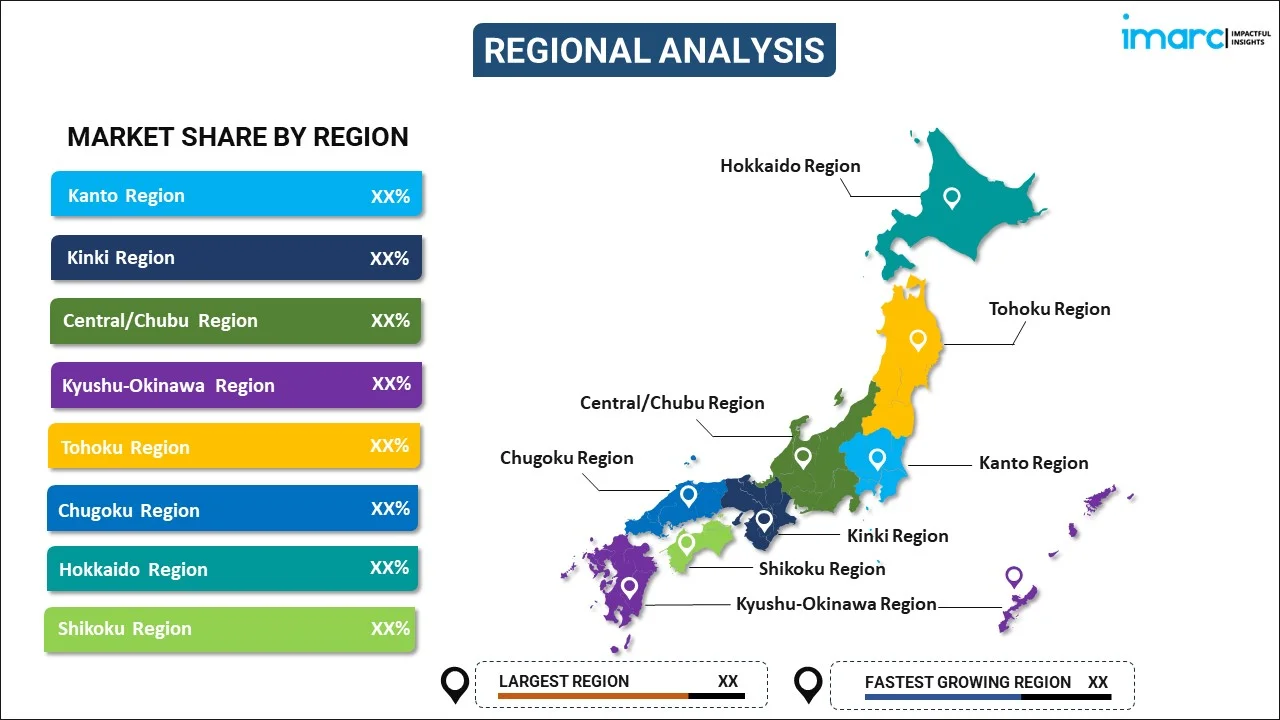
Japan Acetonitrile Market Report by End Use (Pharmaceuticals, Analytical Industry, Agrochemicals, Extraction Industry, and Others), and Region 2025-2033
Market Overview:
The Japan acetonitrile market size reached 15,882 Tons in 2024. Looking forward, IMARC Group expects the market to reach 22,649 Tons by 2033, exhibiting a growth rate (CAGR) of 4% during 2025-2033.
|
Report Attribute
|
Key Statistics
|
|---|---|
|
Base Year
|
2024
|
|
Forecast Years
|
2025-2033
|
|
Historical Years
|
2019-2024
|
|
Market Size in 2024
|
15,882 Tons |
|
Market Forecast in 2033
|
22,649 Tons |
| Market Growth Rate 2025-2033 | 4% |
Acetonitrile is a highly volatile, colorless and flammable liquid, which is also known as methyl cyanide and ethanenitrile. It is commonly available in derivative and solvent variants and is used in acrylic nail removers, batteries and perfumes. It is also utilized as a medium-polarity and aprotic solvent in the natural synthesis and refinement of butadiene. Acetonitrile exhibits high chemical stability and eluting power and is compatible with liquid chromatography-mass spectrometry (LC/MS) solutions. In comparison to methanol, acetonitrile reacts endothermically with water and finds extensive applications across various industries, such as pharmaceuticals, automotive and agriculture.
The Japan acetonitrile market is primarily being driven by the widespread product adoption in the pharmaceutical industry. Acetonitrile is widely used as a starting material to synthesize vitamin A and B1, cortisones, carbonate drugs and amino acids. Moreover, the construction of new acetonitrile manufacturing plants in the country to provide a continuous product supply to various industries is providing a thrust to the market growth. Various product innovations, such as the launch of aqueous acetonitrile, which is used as an extraction solvent to synthesize pesticides and fertilizers, are favoring the market growth. Additionally, the increasing product demand in the automotive industry for producing acrylonitrile butadiene styrene (ABS) plastic with enhanced mechanical strength and chemical resistance is positively impacting the market growth. Other factors, including significant growth in the agrochemical industry and the widespread product adoption for drug recrystallization, are anticipated to drive the market growth across the country.
Key Market Segmentation:
IMARC Group provides an analysis of the key trends in each segment of the Japan acetonitrile market report, along with forecasts at the country and regional levels from 2025-2033. Our report has categorized the market based on end use.
Breakup by End Use:

- Pharmaceuticals
- Analytical Industry
- Agrochemicals
- Extraction Industry
- Others
Breakup by Region:

- Kanto Region
- Kinki Region
- Central/ Chubu Region
- Kyushu-Okinawa Region
- Tohoku Region
- Chugoku Region
- Hokkaido Region
- Shikoku Region
Competitive Landscape:
The competitive landscape of the industry has also been examined along with the profiles of the key players.
Report Coverage:
| Report Features | Details |
|---|---|
| Base Year of the Analysis | 2024 |
| Historical Period | 2019-2024 |
| Forecast Period | 2025-2033 |
| Units | ‘000 Tons |
| Segment Coverage | End Use, Region |
| Region Covered | Kanto Region, Kinki Region, Central/ Chubu Region, Kyushu-Okinawa Region, Tohoku Region, Chugoku Region, Hokkaido Region, Shikoku Region |
| Customization Scope | 10% Free Customization |
| Post-Sale Analyst Support | 10-12 Weeks |
| Delivery Format | PDF and Excel through Email (We can also provide the editable version of the report in PPT/Word format on special request) |
Key Questions Answered in This Report:
- How has the Japan acetonitrile market performed so far and how will it perform in the coming years?
- What has been the impact of COVID-19 on the Japan acetonitrile market?
- What are the key regional markets?
- What is the breakup of the market based on the end use?
- What are the various stages in the value chain of the industry?
- What are the key driving factors and challenges in the industry?
- What is the structure of the Japan acetonitrile market and who are the key players?
- What is the degree of competition in the industry?
Need more help?
- Speak to our experienced analysts for insights on the current market scenarios.
- Include additional segments and countries to customize the report as per your requirement.
- Gain an unparalleled competitive advantage in your domain by understanding how to utilize the report and positively impacting your operations and revenue.
- For further assistance, please connect with our analysts.
 Request Customization
Request Customization
 Speak to an Analyst
Speak to an Analyst
 Request Brochure
Request Brochure
 Inquire Before Buying
Inquire Before Buying




.webp)




.webp)












